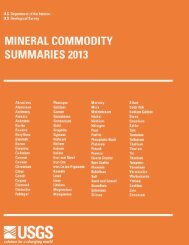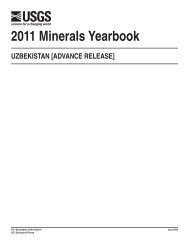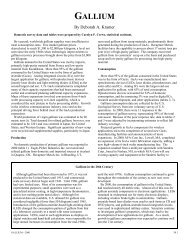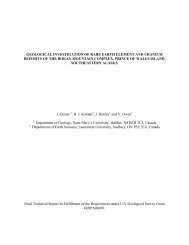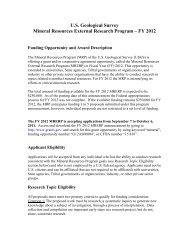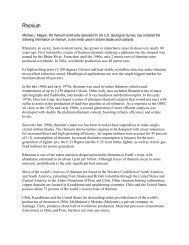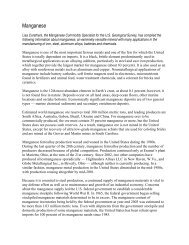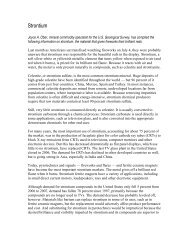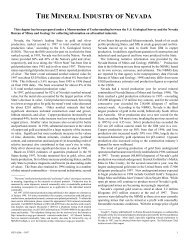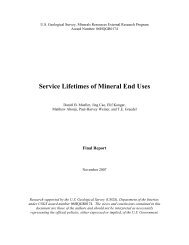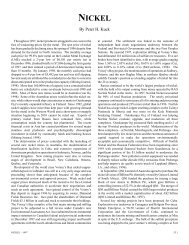Mineral Commodity Summaries 2003 - Mineral Resources Program ...
Mineral Commodity Summaries 2003 - Mineral Resources Program ...
Mineral Commodity Summaries 2003 - Mineral Resources Program ...
Create successful ePaper yourself
Turn your PDF publications into a flip-book with our unique Google optimized e-Paper software.
10<br />
in some cases, were ascribable to fiscal problems that<br />
were allowed to become monetary problems because<br />
currencies were manipulated to manage debt. Africa<br />
continued to provide the world with a variety of mineral<br />
resources while suffering revolutions, coups, land grabs,<br />
and the danger of starvation. Russia continued its<br />
transition to a market economy and tried to increase<br />
startup industry and output.<br />
The common problem for much of the world seemed<br />
to be a lack of committed investment capital to spark the<br />
confidence that would rebuild productivity worldwide.<br />
Compounding the overall economic problem was the<br />
spectre of a war with Iraq. Major world economies and<br />
some minor economies that have been unable to create<br />
economic growth based on demand from their own<br />
enterprises and consumers have been relying on the<br />
U.S. consumer to sustain a demand for imports. The<br />
U.S. consumer has been willing thus far, but a certain<br />
proportion of the load has been charged to credit cards<br />
and other small-loan sources, neither of which are<br />
unlimited. Thus the strength of the U.S. economy has<br />
diminished and now relies to a greater extent on the<br />
collective purchasing power of its citizens. There were a<br />
few brighter spots. China enjoyed solid growth in its<br />
gross domestic product (GDP) during the previous year<br />
and provided increasing demands for exports, which<br />
included mineral commodities, from other Asian<br />
countries. The Republic of Korea expanded its capital<br />
markets to attract foreign portfolio investment.<br />
Thailand’s recovery and growth was led by consumer<br />
demand. Overall direction of the world economy<br />
concerning growth or recession was unclear.<br />
Review of National or Regional Economies<br />
The decline of equities markets reduced the effect of<br />
the United States as the source of economic strength<br />
that the world had come to accept. “Irrational<br />
exuberance,” particularly in the technological stocks,<br />
was gradually replaced by uncertainty and caution. The<br />
situation was not helped by a string of revelations of<br />
financial irregularities at the highest levels of several<br />
major corporations. This exacerbated the weakening of<br />
confidence in the equities markets, which resulted in a<br />
reduction or collapse of asset values throughout the<br />
national economy. By generating a diminished<br />
proportion of demand growth of the world economy, the<br />
United States no longer provided unlimited time for other<br />
countries to restructure their fiscal systems, to reduce<br />
interest rates, and to adjust their trade arrangements to<br />
participate in a global expansion. With the economy<br />
already weakened by a recession, newly established<br />
U.S. tariffs on a variety of steel products, which included<br />
rolled steel and steel wire, were met by threats of<br />
retaliation by the European Union (EU) and other<br />
countries.<br />
Because Japan has shown little progress in<br />
confronting the problems that resulted from the collapse<br />
of domestic real estate values more than a decade ago,<br />
the domestic debt structure has been affected to the<br />
point that banks have become overwhelmed by<br />
nonperforming loans. Consequently, calling the loans<br />
would result in a plethora of prominent bankruptcies with<br />
consequent effects on labor, credit, and investment. Not<br />
calling the loans, however, could put the separate<br />
banks, if not the entire banking system, in jeopardy.<br />
Fixing the banks would be important for several reasons<br />
(Dvorak, 2002). Because bank lending is about equal to<br />
total economic output, banks are the main funnel of cash<br />
to Japanese business, a funnel that many believe is<br />
jammed. So long as banks keep nonperforming<br />
“deadbeat” corporate borrowers in business, other<br />
healthier companies will not get the funding they need to<br />
grow. The size of Japan’s loan-default problem is<br />
thought to be so large that the banks are not able to<br />
handle the losses on their own. Taking bad loans off<br />
banks’ books will not solve the problem. Failing<br />
borrowers must be liquidated or restructured and their<br />
depreciated assets sold at market prices. Resistance to<br />
doing this is based at least partly on the intricacies of<br />
Japanese politics. Devaluing the yen might stimulate<br />
exports and improve cash flow, but other Asian countries<br />
would lose market share that they need to support their<br />
own economic recoveries. As with the United States,<br />
Japan needs consumer demand to help keep its<br />
economy afloat, but much potential consumer<br />
purchasing power is going into savings. The weakness<br />
of the Japanese banking system could have an<br />
important effect on the supply of minerals because<br />
Japanese companies have been avid investors in<br />
natural resources projects throughout the world for<br />
several decades. The continuation of such investments<br />
will be important to a world in which the development of<br />
countries with large populations, most notably China and<br />
India, will significantly increase the demand for minerals.<br />
As the largest economy in the EU, Germany’s<br />
economic strength or weakness is reflected by<br />
fluctuations in the value of the euro versus that of other<br />
currencies. After the decline of the U.S. equities<br />
markets and investment shifting to EU countries, the<br />
value of the euro climbed closer to the value of the<br />
dollar, but Germany’s economy is being severely tested<br />
by domestic fiscal and labor policies as well as natural<br />
disasters. In August, a catastrophic flood inundated<br />
much of the eastern provinces. In Saxony, for example,<br />
180 bridges, 20% of the rail network, and 480 miles of<br />
roads were destroyed or made unusable; Dresden, the<br />
capital, was severely damaged. Physical rebuilding will<br />
cost roughly $20 billion, with social costs more difficult to<br />
reckon, and all at a time of stagnation of the German<br />
economy (Kielinger, 2002). To repair the flood damage,<br />
an anticipated tax cut was postponed, and corporate<br />
taxes were increased. Germany has 10%<br />
unemployment, and layoffs are at record highs for skilled<br />
and unskilled workers. As in Japan, consumer savings<br />
are up sharply. Perhaps least tractable is the burden of<br />
labor and social entitlement costs that militate against<br />
new hiring. The European Central Bank has seen no<br />
urgency to cut its lending rates to stimulate investment.<br />
In the meantime, European productivity loses ground.<br />
Progress is being made, however, in adopting a uniform<br />
set of financial standards for the EU, starting with a<br />
single accounting standard for all listed companies in the<br />
EU.<br />
Late in 2001, the EU announced a significant<br />
expansion; it has agreed to welcome 10 new<br />
members—Bulgaria, Cyprus, Czech Republic, Estonia,<br />
Hungary, Latvia, Lithuania, Malta, Poland, Romania,<br />
Slovakia, and Slovenia—by 2004. EU firms have<br />
invested in the cement industries of Eastern European



